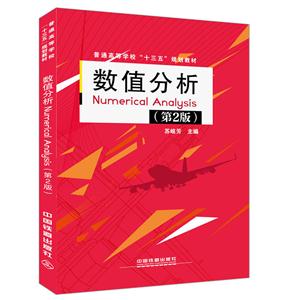1 Error Analysis ......1
1.1 Introduction ............ 1
1.2 Sources of Errors .... 2
1.3 Errors and Significant Digits
.......... 4
1.4 Error Propagation ... 8
1.5 Qualitative Analysis and Control of
Errors ............ 9
1.5.1 Ill-condition Problem and Condition
Number....................... 9
1.5.2 The Stability of Algorithm .. 10
1.5.3 The Control of Errors .......... 11
1.6 Computer Experiments.................
14
1.6.1 Functions Needed in the Experiments
by Mathematica ...... 14
1.6.2 Experiments by
Mathematica...................... 14
1.6.3 Functions Needed in the Experiments
by Matlab................ 16
1.6.4 Experiments by Matlab ....... 16
Exercises 1..................... 17
2 Interpolating.......19
2.1 Introduction .......... 20
2.2 Basic Concepts ..... 21
2.3 Lagrange Interpolation
................. 22
2.3.1 Linear and Parabolic Interpolation
.............. 22
2.3.2 Lagrange Interpolation
Polynomial............. 24
2.3.3 Interpolation Remainder and Error
Estimate....................... 25
2.4 Divided-differences and Newton
Interpolation .... 29
2.5 Differences and Newton Difference
Formulae..... 33
2.5.1 Differences .. 33
2.5.2 Newton Difference Formulae ......................
35
2.6 Hermite Interpolation
................... 38
2.7 Piecewise Low Degree
Interpolation.................... 42
2.7.1 Ill-posed Properties of High Degree
Interpolation .............. 42
2.7.2 Piecewise Linear Interpolation
.................... 43
2.7.3 Piecewise Cubic Hermite
Interpolation....... 44
2.8 Cubic Spline Interpolation............
45
2.8.1 Definition of Cubic Spline... 45
2.8.2 The Construction of Cubic Spline
............... 46
2.9 Computer Experiments.................
49
2.9.1 Functions Needed in the Experiments
by Mathematica ...... 49
2.9.2 Experiments by
Mathematica...................... 50
2.9.3 Experiments by Matlab ....... 56
Exercises 2................... 64
3 Best Approximation ...................68
3.1 Introduction .......... 68
3.2 Norms ................... 69
3.2.1 Vector Norms ......................
69
3.2.2 Matrix Norms ......................
74
3.3 Spectral Radius..... 76
3.4 Best Linear Approximation .......... 79
3.4.1 Basic Concepts and
Theories....................... 79
3.4.2 Best Linear Approximation . 81
3.5 Discrete Least Squares Approximation
................ 82
3.6 Least Squares Approximation and
Orthogonal Polynomials........ 87
3.7 Rational Function Approximation 94
3.7.1 Continued Fractions ............ 94
3.7.2 Padé Approximation............ 97
3.8 Computer Experiments.................
99
3.8.1 Functions Needed in The Experiments
by Mathematica..... 99
3.8.2 Experiments by
Mathematica.................... 100
3.8.3 Functions Needed in The Experiments
by Matlab ............ 106
3.8.4 Experiments by Matlab ..... 106
Exercises 3................. 111
4 Numerical Integration and Differentiation
........114
4.1 Introduction ........ 115
4.2 Interpolatory Quadratures...........
116
4.2.1 Interpolatory Quadratures.. 116
4.2.2 Degree of Accuracy........... 117
4.3 Newton-Cotes Quadrature
Formula.................... 118
4.4 Composite Quadrature Formula . 123
4.4.1 Composite Trapezoidal Rule .....................
123
4.4.2 Composite Simpson’s Rule
....................... 124
4.5 Romberg Integration...................
125
4.5.1 Recursive Trapezoidal Rule
...................... 125
4.5.2 Romberg Algorithm .......... 126
4.5.3 Richardson’s Extrapolation
....................... 128
4.6 Gaussian Quadrature Formula .... 129
4.7 Multiple Integrals
....................... 134
4.8 Numerical Differentiation...........
135
4.8.1 Numerical Differentiation . 135
4.8.2 Differentiation Polynomial
Interpolation .. 137
4.8.3 Richardson’s Extrapolation
....................... 141
4.9 Computer Experiments............... 144
4.9.1 Functions Needed in the Experiments
by Mathematica .... 144
4.9.2 Experiments by
Mathematica.................... 144
4.9.3 Experiments by Matlab ..... 149
Exercises 4................... 153
5 Solution of Nonlinear Equations
......................156
5.1 Introduction ........ 156
5.2 Basic Theories .... 158
5.3 Bisection Method 159
5.4 Iterative Method and Its
Convergence................ 162
5.4.1 Fixed Point and Iteration ... 162
5.4.2 Global Convergence.......... 163
5.4.3 Local Convergence............ 165
5.4.4 Order of Convergence ....... 167
5.5 Accelerating Convergence.......... 168
5.6 Newton’s Method .......................
170
5.6.1 Newton’s Method and Its Convergence
.... 170
5.6.2 Reduced Newton Method and Newton’s
Descent Method ....................... 172
5.6.3 The Case of Multiple
Roots....................... 173
5.7 Secant Method and Muller Method
.................... 174
5.7.1 Secant Method................... 174
5.7.2 Muller Method................... 175
5.8 Systems of Nonlinear Equations. 176
5.9 Computer Experiments............... 179
5.9.1 Functions Needed in the Experiments
by Mathematica .... 179
5.9.2 Experiments by
Mathematica.................... 180
5.9.3 Experiments by Matlab ..... 185
Exercises 5................. 188
6 Direct Methods for Solving Linear Systems
....191
6.1 Introduction ........ 192
6.2 Gaussian Elimination..................
193
6.2.1 Basic Gaussian
Elimination....................... 193
6.2.2 Triangular Decomposition. 197
6.3 Gaussian Elimination with Column
Pivoting ..... 200
6.4 Methods of the Triangular
Decomposition......... 202
6.4.1 The Direct Methods of The Triangular
Decomposition .... 202
6.4.2 The Square Root Method .. 203
6.4.3 The Speedup Method......... 206
6.5 Analysis of Round-off Errors ..... 210
6.5.1 Condition Number............. 210
6.5.2 Iterative Refinement .......... 214
6.6 Computer Experiments............... 215
6.6.1 Functions Needed in the Experiments
by Mathematica .... 215
6.6.2 Experiments by
Mathematica.................... 215
6.6.3 Functions Needed in the Experiments
by Matlab.............. 222
6.6.4 Experiments by Matlab ..... 222
Exercises 6................... 227
7 Iterative Techniques for Solving Linear
Systems ....................230
7.1 Introduction ........ 231
7.2 Basic Iterative Methods ..............
233
7.2.1 Jacobi Method ................... 234
7.2.2 Gauss-Seidel Method ........ 236
7.2.3 SOR Method...................... 237
7.3 Iterative Method Convergence ... 238
7.3.1 Basic Theorems ................. 238
7.3.2 Some Special Systems of
Equations.......... 243
7.4 Computer Experiments............... 247
7.4.1 Functions Needed in The Experiments by
Mathematica... 247
7.4.2 Experiments by
Mathematica.................... 247
7.4.3 Experiments by Matlab ..... 251
Exercises 7................... 255
8 Numerical Solution of Ordinary
Differential Equations ............258
8.1 Introduction ........ 258
8.2 The Existence and Uniqueness of
Solutions....... 260
8.3 Taylor-Series Method.................
262
8.4 Euler’s Method ... 263
8.5 Single-step Methods ...................
267
8.5.1 Single-step Methods.......... 267
8.5.2 Local Truncation Error ...... 267
8.6 Runge-Kutta Methods ................
268
8.6.1 Second-Order Runge-Kutta
Method.......... 268
8.6.2 Fourth-Order Runge-Kutta
Method........... 270
8.7 Multistep Methods......................
271
8.7.1 General Formulas of Multistep
Methods... 272
8.7.2 Adams Explicit and Implicit
Formulas...... 273
8.8 Systems and Higher-Order Differential
Equations..................... 275
8.8.1 Vector Notation ................. 276
8.8.2 Taylor-Series Method for
Systems............ 278
8.8.3 Fourth-Order Runge-Kutta Formula for
Systems.............. 279
8.9 Computer Experiments............... 281
8.9.1 Functions Needed in the Experiments
by Mathematica .... 281
8.9.2 Experiments by
Mathematica.................... 281
8.9.3 Experiments by Matlab ..... 286
Exercises 8................... 290
Appendix ...............293
Appendix A Mathematica Basic Operations
............ 293
Appendix B Matlab Basic Operations
...................... 309
Appendix C Answers to Selected
Question.............. 327
Reference..............332





















